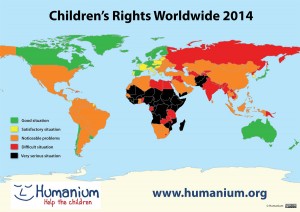The Realization of Children’s Rights Index (RCRI), created by the international NGO Humanium, provides a demonstration of the level of respect for children’s rights in each country in the world. This grade between 0 and 10 also allows the situation of children in the world to be visually represented using colour coding.
The 2014 classification of countries and the corresponding map reveals that the global situation is still very worrying – in some cases, tragic.
Africa
“The children’s rights situation in Africa remains critical. Their rights are still widely flouted by the States.
At the top of the global classification of countries, among those that respect children’s rights the least are 10 African countries: Somalia (occupying the deplorable first place in this classification), the Democratic Republic of Congo, the Central African Republic, Tchad…
Conflicts, political instability, and especially poverty, are all damaging factors with respect to the wellbeing of African children.
Nevertheless, some countries have established policies in favour of children and signs of progress are starting to show (Benin and Senegal have moved out of the black into red and orange).
Others are relying on a more favourable economic situation to improve the living conditions for children (South Africa, Ghana and Namibia).
Efforts in the fight against poverty should be intensified, particularly in terms of access to basic social services, including education, health services and water.”
 Henintsoa Ravoala
Henintsoa Ravoala
African Coordinator
Americas
“In 2014, the respect for children’s rights in American countries should improve.
In general, this part of the world does not have the best record. Indeed, the vast majority of the States are in the orange, that is, encountering significant issues.
Only 5 countries differ in this respect: Canada, Chile and Uruguay have a good record with grades of higher than 8 out of 10 for their respect of children’s rights. They are closely followed by the island of Antigua and Barbuda, and Panama, where the situation is good (in yellow).
Unfortunately, the country where the situation for children is the most alarming is Haiti, with a grade of just over 5 out of 10. The situation in this country remains unchanged since last year.
Difficulties are still very much ongoing. Efforts to fight poverty and corruption in particular are crucial points in order to offer the best respect for the fundamental rights of young Haitians.”
 Mallorie Tarpin-Lyonnet
Mallorie Tarpin-Lyonnet
Americas Coordinator
Asia and Pacific
“The situation across the countries in the Asian and Pacific region is very varied. It should be noted that the country that least respects children’s rights in the world is Afghanistan, a worrying fact which is due to the unstable political context in the country.
Despite considerable encouraging improvements, children in more than half of the countries in the region are confronted with significant problems, reflecting the significant efforts that need to be made in order to achieve a satisfactory situation.
The emerging countries, which are China (orange), India (red) and Russia (red) do not provide a good example; the level of respect for children’s rights is indeed worrying and requires immediate action, particularly in terms of civil and political freedoms.”
Marlène Joris
Asia and Pacific Coordinator
Europe and the Caucasus
“According to the global classification in relation to Children’s Rights, there has been success in Western Europe, with Liechtenstein in the lead, followed by Ireland, Germany, Finland, Switzerland, the Netherlands and Norway.
The situation of children in the rest of Europe, particularly in the Balkans, is less positive.
This is mainly due to the economic crisis, on the one hand, and, on the other hand, gaps in the education system.
However, within the context of negotiation with the European Union, the respective governments have shown their commitment to implementing public policies with the aim of promoting the protection of children. We can therefore expect an improvement over the coming years.
As for the fragile States in the Caucasus, racked with poverty and having experienced destructive conflicts in recent years, there are still significant problems, especially in rural areas. Indeed, not only do children lack access to health services, but child marriage and the conditions they have to face in terms of education are areas for improvement.”
 Asli Kaya
Asli Kaya
Europe and the Caucasus Coordinator
Middle East and North Africa
“The state of children’s rights remains cause for concern in the Middle East and in North Africa.
Not one of the countries in this region is in the green. On the map created by Humanium, orange dominates, attesting to the fact that the majority of these countries have numerous problems with the application and respect of children’s rights.
Young Yemenis and Mauritanians are in a very serious situation, with almost all of their fundamental rights being violated.
The principle of “the best interests of the child” should be integrated more quickly into governmental policies.
Iraq, Egypt and Libya are in the red, which is most certainly a warning. These countries, which have lived through the Arab revolutions, should now begin to stabilise in order to be able to offer their young people a true spring.
Syria is also in the red. Since 2011, the situation for children in the country has considerably deteriorated as a result of the conflict. More than seven thousand children may have lost their lives since the start of the war, and this figure will only continue to rise until the situation is resolved.”



